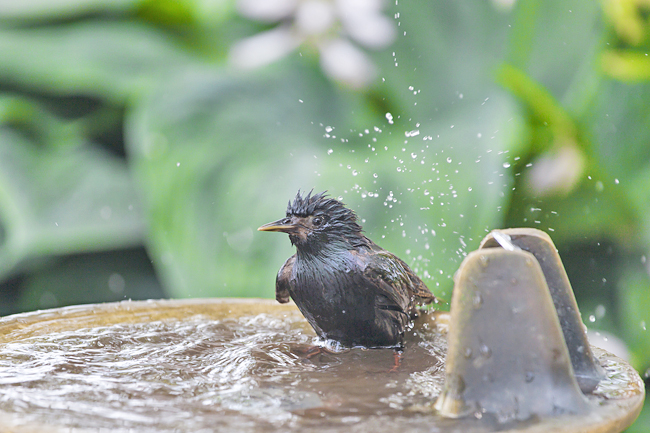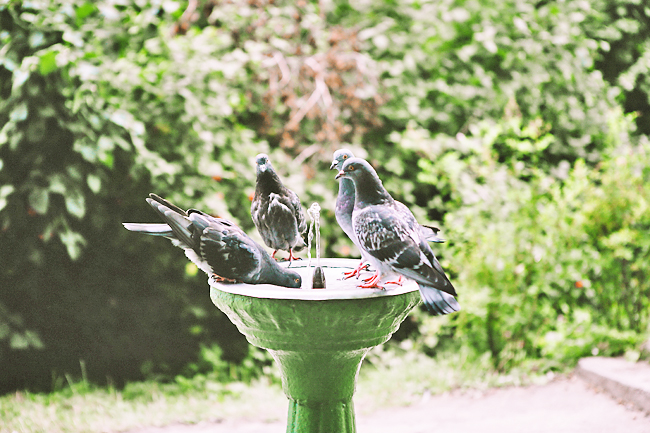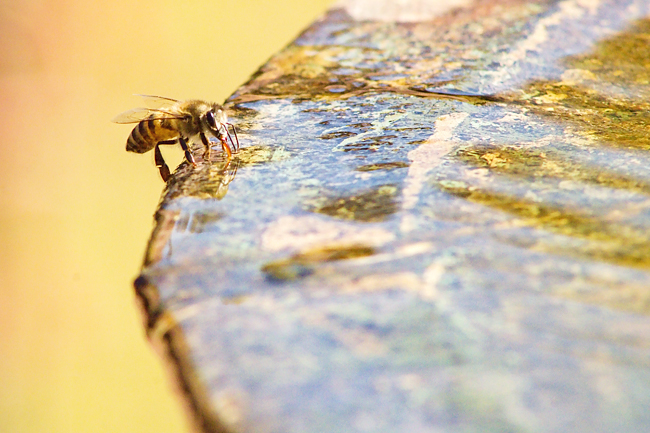THE WASHINGTON POST – The sight of a drooping flower head is often all it takes to prod us to unravel the hose and turn on the spigot. We’re less attuned to the water preferences and needs of birds and insects, though, and we may unintentionally leave them high and dry.
That’s probably at least in part because no one water source meets all their needs. “When we talk about water in a garden, we need to not just picture a bowl of water or a birdbath or a pond,” said director Matthew Shepherd of outreach and education for the Xerces Society for Invertebrate Conservation in Portland, Ore. “It’s also moisture, wet ground and mud.”
The hotter and drier weather caused by climate change is leaving wildlife especially vulnerable, but there are things gardeners and homeowners can do to help. The first step is understanding the varied ways birds and invertebrates find and use water.
“You’re creating a comprehensive habitat that will support all life stages,” said Shepherd.
“Water is one of those components.”



BIRDS
Birds, who need water for bathing and drinking, are particularly drawn to the sight and sound of moving water. A splash, gurgle or drip – even just a silent rippling – will keep resident birds and attract thirsty new ones, so consider adding a fountain or pump to your birdbath. As an added bonus, the moving water won’t attract mosquitoes.
A solar, electric or battery-operated pump fountain in a one- to three-inch deep birdbath will accommodate most birds. These devices are relatively inexpensive, but they can be prone to clogging from bird and organic debris. Consider using a solar fountain pump that sits inside a mesh bag in a container below the fountain to prevent clogs.
Another option is a three-legged battery- or solar-operated water agitator that stands in the birdbath, with a hanging spinner to create ripples.
These devices may not attract as many birds as the sound of a fountain, but they’re low maintenance.
And remember, any birdbath deeper than two inches should have rocks or sticks to act as perches for small birds such as sparrows and songbirds.
HUMMINGBIRDS
Hummingbirds meet their hydration needs via sugar-water feeders and nectar-producing flowers. They still need water to bathe and keep cool, but a traditional birdbath is too deep.
“They can drown in it, or they’ll sit on the edge, but they won’t go in,” said a federally licenced bird bander in Harrisburg, Pennsylvania Sandy Lockerman.
In nature, a rain shower, shallow stream or waterfall spray does the trick. But you can modify a typical birdbath to make it suitable for hummers.
Attach a mister or dripper to the bath and fill it with rocks, or place rocks atop a low-gurgling fountain to mimic a gentle stream. In all cases, ensure the water is shallow.
FIREFLIES
With the right conditions, you can attract enough fireflies to your yard. Avoid pesticides and outdoor lighting, mow the grass on a high setting and less frequently, and provide moisture.
“Fireflies don’t necessarily need water, but they need damp conditions,” said Shepherd.
In the wild, the ideal firefly habitat is where field meets stream. You can replicate this with native grasses and flowering plants, shrubs, or unmown lawn near a rain garden, pond or other water feature. Damp leaf litter in these areas provides habitat for eggs and larvae to develop – stages that make up the majority of the insects’ lives.
BUTTERFLIES
Butterflies meet their hydration needs via nectar. However, some species – including tiger swallowtails, sulfurs, white admirals, skippers and checkerspots – need places to “puddle”, or sip minerals from mud, wet sand or an actual puddle. It’s not uncommon to see several butterflies puddling together.
It’s mainly males that puddle, because they “take the nutrients to create the sperm packets that they transfer to females during breeding”, said Shepherd.
To create a puddle for butterflies, fill a shallow dish or container with soil or sand; add flat rocks for perching; moisten the soil or sand with water; and keep it moist during the heat of the day.
Some suggest adding salt or a piece of overripe fruit, which can provide minerals found in natural puddles.
A drip irrigation system or an area where water collects on the soil can also create an attractive spot for butterflies.
BEES
They can’t swim, but bees drink water via a proboscis (a long slender tongue that works like a straw), store it in an organ called the “honey stomach”, then transfer it to their hives.
Bees find water in damp rocks, muddy puddles, pond edges and drops adhering to vegetation, or via drip irrigation systems and sprinkler heads. Do-it-yourself bee watering stations can be made by filling a shallow container with marbles, small stones or sticks and just enough water so a bee won’t drown if it falls in.
Place it near flowers they prefer to ensure they find it.
Honeybees need water to regulate the temperature of the hive, feed young bees and dilute stored honey. Native bees also use it to build their nests.
Ground nesting species, including digger bees, use water to soften the ground to build a nest. Cavity nesting bees make nests in dead wood, hollow stems or store-bought or homemade bee houses, but they need clay-rich mud to divide the nest into brood cells and to seal openings against predators.
You can set out your own mud mix or purchase mason bee mud mix.
DRAGONFLIES AND DAMSELFLIES
If you live near a lake, pond, stream or creek, chances are dragonflies and damselflies visit your yard. “They’ll travel a long way away from water to find food,” said Shepherd.
But if you want these aquatic insects as permanent residents, you’ll need a pond.
As nymphs, they spend two or more years in water. As adults, they fly over water hunting for mosquitoes, mayflies and midges.
A dragonfly pond needs sun, a range of water depths and diverse plant types such as submerged, floating and upland plants, according to backyard pond guidelines issued by Xerces.
It doesn’t have to be large; Shepherd has seen dragonflies successfully breed in a four-foot-by-six-foot pond he installed himself.










